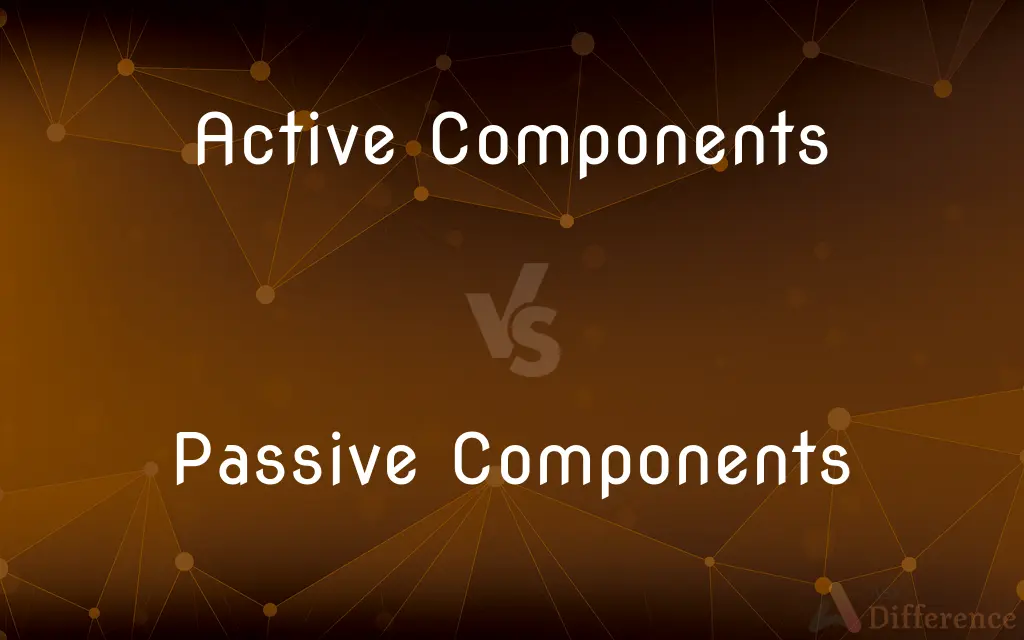Active Components vs. Passive Components — What's the Difference?
Edited by Tayyaba Rehman — By Urooj Arif — Published on May 5, 2024
Active components can amplify signals and require a power source, whereas passive components cannot amplify and do not need external power, merely managing energy flow in circuits.

Difference Between Active Components and Passive Components
Table of Contents
ADVERTISEMENT
Key Differences
Active components are defined by their ability to amplify electrical signals and require an external power source to function. They play a crucial role in the generation, amplification, and processing of electronic signals, making them indispensable in complex electronic circuits.
Passive components, in contrast, do not have the capability to amplify signals and do not require any external power source to operate. They are fundamental in controlling and restricting the flow of electric current, shaping the behavior of circuits through resistance, capacitance, and inductance.
Active components like transistors and integrated circuits are the backbone of digital electronics, enabling the creation of complex computing systems, whereas passive components such as resistors, capacitors, and inductors provide essential functions like filtering, impedance matching, and energy storage in both analog and digital circuits.
The interplay between active and passive components is vital for the design of electronic circuits. Active components rely on passive components to stabilize their operation, filter noise, and shape signal characteristics, showcasing a symbiotic relationship essential for circuit functionality.
Active and passive components differ significantly in their roles within electronic circuits, but both are equally important. The choice between using an active or passive component depends on the specific requirements of the circuit, such as the need for amplification, filtering, or energy management.
ADVERTISEMENT
Comparison Chart
Function
Amplify signals and power electronic circuits
Manage the flow of electricity without amplification
Power Requirement
Require an external power source
Do not need an external power source
Examples
Transistors, Integrated Circuits (ICs)
Resistors, Capacitors, Inductors
Role in Circuits
Processing and generating signals
Filtering, energy storage, and impedance matching
Complexity
Generally more complex, enabling advanced functionalities
Simpler, providing fundamental electrical characteristics
Compare with Definitions
Active Components
Active components control the flow of electricity with amplification.
A transistor amplifies a small input signal into a larger output signal.
Passive Components
Passive components are fundamental in circuit design.
A resistor sets the biasing conditions in a circuit.
Active Components
Active components are used in oscillators.
A transistor oscillator generates a continuous periodic waveform.
Passive Components
Passive components are used for impedance matching.
An inductor can match impedances in RF circuits.
Active Components
Active components require external power.
A diode requires forward bias to conduct electricity.
Passive Components
They cannot amplify signals.
A capacitor filters out AC signals but does not amplify them.
Active Components
They are essential for signal processing.
An integrated circuit processes digital signals in a computer.
Passive Components
They do not require external power to operate.
A capacitor stores electrical energy in an electric field.
Active Components
They can generate energy in the form of voltage or current.
A vacuum tube amplifies signals in vintage audio equipment.
Passive Components
Passive components resist, store, or filter electrical energy.
A resistor reduces current flow.
Common Curiosities
What distinguishes active components from passive ones?
Active components can amplify signals and need external power, while passive components cannot amplify and don’t need power.
Can an active component function without a passive component in a circuit?
While technically possible, passive components are often needed for stability, filtering, and impedance matching.
Why do active components require an external power source?
They need power for amplification and to perform their active functions within circuits.
Can passive components work without active components in a circuit?
Yes, passive components can work without active components in simple circuits for tasks like filtering.
Do all electronic devices use both active and passive components?
Most complex electronic devices use both for various functions, including amplification and signal processing.
Can active components be used for filtering?
Yes, especially in active filtering circuits where amplification and precision filtering are needed.
What role do resistors play in electronic circuits?
Resistors control current flow and are crucial for setting operating conditions.
Are batteries considered active components?
Batteries are power sources, not active components, as they do not amplify signals.
What is the significance of impedance matching in circuits?
Impedance matching maximizes power transfer and minimizes signal reflection, crucial in RF and audio applications.
How do capacitors and inductors differ in function?
Capacitors store energy in an electric field, while inductors store energy in a magnetic field, but both can filter and manage signal frequencies.
How do integrated circuits fit into the comparison?
Integrated circuits are active components that can perform complex processing and amplification tasks.
Why are passive components considered simpler?
They have no active functions like amplification and require no external power, making their design and operation simpler.
Can a circuit operate with only active components?
No, passive components are needed for basic functions like current limiting and filtering for stability.
How do passive components contribute to energy efficiency in circuits?
By managing current flow and filtering, they help minimize energy loss and improve circuit efficiency.
What makes active components indispensable in digital electronics?
Their ability to process and generate signals is crucial for the operation of digital systems.
Share Your Discovery

Previous Comparison
Meniere’s vs. Labyrinthitis
Next Comparison
HP vs. BHPAuthor Spotlight
Written by
Urooj ArifUrooj is a skilled content writer at Ask Difference, known for her exceptional ability to simplify complex topics into engaging and informative content. With a passion for research and a flair for clear, concise writing, she consistently delivers articles that resonate with our diverse audience.
Edited by
Tayyaba RehmanTayyaba Rehman is a distinguished writer, currently serving as a primary contributor to askdifference.com. As a researcher in semantics and etymology, Tayyaba's passion for the complexity of languages and their distinctions has found a perfect home on the platform. Tayyaba delves into the intricacies of language, distinguishing between commonly confused words and phrases, thereby providing clarity for readers worldwide.
















































